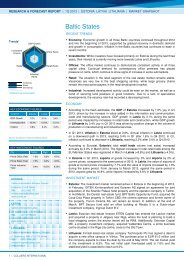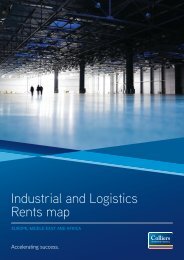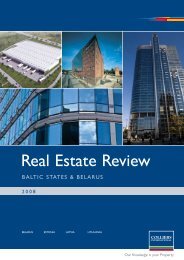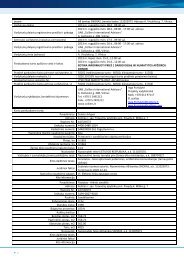baltic states and belarus real estate market review - Colliers
baltic states and belarus real estate market review - Colliers
baltic states and belarus real estate market review - Colliers
You also want an ePaper? Increase the reach of your titles
YUMPU automatically turns print PDFs into web optimized ePapers that Google loves.
Real Estate Market Review 2011 | Lithuania Warehouse Market<br />
Warehouse Rental Rates<br />
* - asking rental rates (EUR/sqm/month) excluding<br />
VAT <strong>and</strong> operating expenses<br />
- stable, - slight increase<br />
Region Rates* Trends<br />
Vilnius 2.9 - 4.1 <br />
Kaunas 2.6 - 3.8 <br />
Klaipeda 2.6 - 3.8 <br />
Rental Rates (EUR)<br />
Dynamics of Rental Rates*<br />
* - asking rental rates (EUR/sqm/month) excluding<br />
VAT <strong>and</strong> operating expenses<br />
5.5<br />
5.0<br />
4.5<br />
4.0<br />
3.5<br />
3.0<br />
2.5<br />
2.0<br />
2005<br />
2006<br />
Vilnius Region<br />
Klaipeda Region<br />
2007<br />
2008<br />
2009<br />
Kaunas Region<br />
2010<br />
Vacancy rates <strong>and</strong> Trends<br />
- slight decrease<br />
Region Vacancy Trends<br />
Vilnius 9.5 % <br />
Kaunas 3.0 % <br />
Klaipeda 13.0 % <br />
Dynamics of Vacancy Rates<br />
compared to new companies entering the<br />
Lithuanian <strong>market</strong>, were relocating or<br />
exp<strong>and</strong>ing their business in the local <strong>market</strong>.<br />
Among tenants of existing warehouses,<br />
renegotiation of rent rates, discount periods,<br />
rent free periods <strong>and</strong>/or downsizing were<br />
common practices.<br />
RENTAL RATES<br />
Although vacancy remains low in the logistics<br />
<strong>market</strong>, average rental levels were pushed<br />
downwards in the first half of the year due to<br />
warehouse owners’ desire to retain existing<br />
tenants <strong>and</strong> to attract potential new tenants,<br />
gaining at least minimum income flows for<br />
further financial commitments.<br />
During 2HY 2010, asking warehouse rental<br />
rates remained stable due to a sufficiently<br />
high level of occupancy. Cases of agreed<br />
rental prices signed at below-<strong>market</strong> range<br />
exist, but such cases are isolated, <strong>and</strong> only<br />
where conditions have been offered a strong<br />
position, with tenants who occupy very large<br />
areas (up to 15,000 - 20,000 sqm).<br />
The rental range remained fairly wide,<br />
indicating space for negotiation. Higher<br />
rental rates were asked from tenants with<br />
exceptional requirements for premises.<br />
Rent rate level stabilisation was seen during<br />
the year of 2010, with only a minor decrease<br />
of 5 - 10 per cent recorded. L<strong>and</strong>lords are<br />
already bordering on rental rate levels where<br />
investment is economically unprofitable <strong>and</strong><br />
financially unattractive <strong>and</strong> further price<br />
reductions would amount to desperate<br />
actions to overcome difficulties at any cost.<br />
VACANCY<br />
In 2010 slight fluctuation in the vacancy rate<br />
were seen. Since new supply was not added<br />
to the <strong>market</strong>, existing vacant space was<br />
absorbed by relocation, expansions, or new<br />
companies entering the <strong>market</strong>. By the end of<br />
the year the vacancy level was approximately<br />
9 - 10 per cent.<br />
It should be noted that the vacancy level<br />
indicator does not show the <strong>real</strong> situation in<br />
the warehouse <strong>market</strong> as only the un-leased<br />
space is taken into account. The tenants of<br />
leased space providing logistic services are<br />
servicing fewer clients <strong>and</strong> have additional<br />
empty premises under leases that are not<br />
included in these statistics.<br />
In 2011 vacancy levels should not increase<br />
due to the lack of new speculative project<br />
development with all 2011 projects expected<br />
to be developed on built-to-suit basis.<br />
Tendencies AND FORECAST<br />
◊<br />
◊<br />
◊<br />
The prolonged economic slowdown <strong>and</strong><br />
credit policy of banks for warehousing<br />
projects will impact the feasibility of<br />
new developments. New projects will be<br />
started only after finding tenants (the<br />
construction on built-to-suit basis), <strong>and</strong><br />
in their absence, project implementation<br />
will be postponed.<br />
2011 will not face rent rate decline as<br />
the breakeven limit already has been<br />
reached. Similarly, a significant increase<br />
of rent rates is not expected as the<br />
economic recovery is slow. L<strong>and</strong>lords<br />
will be forced by financial institutions to<br />
start rent indexation renewal <strong>and</strong> step<br />
rent application. Due to these actions<br />
average <strong>market</strong> rent rate may increase<br />
by 5 - 10 per cent during 2011.<br />
New projects that add to the <strong>market</strong><br />
supply cause a vacancy rate increase. It<br />
is forecasted to remain unchanged or to<br />
decline gradually.<br />
18%<br />
16%<br />
14%<br />
12%<br />
10%<br />
8%<br />
6%<br />
4%<br />
2%<br />
0%<br />
2007 2008 2009 2010 2011<br />
Vilnius Region Kaunas Region<br />
Klaipeda Region<br />
CONTACT: RAMUNE ASKINIENE - r.askiniene@colliers.lt<br />
<strong>Colliers</strong> International | p. 41













